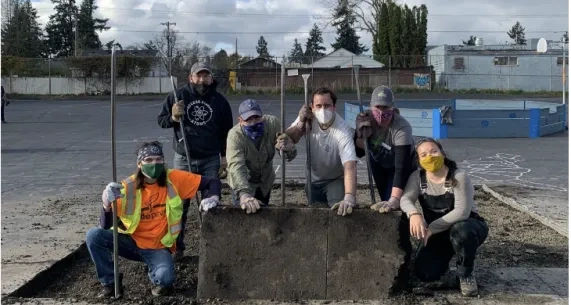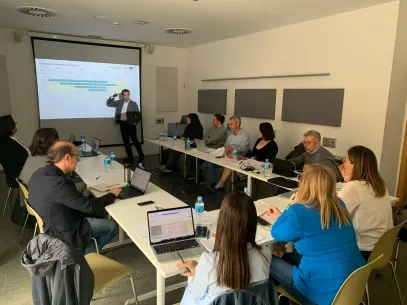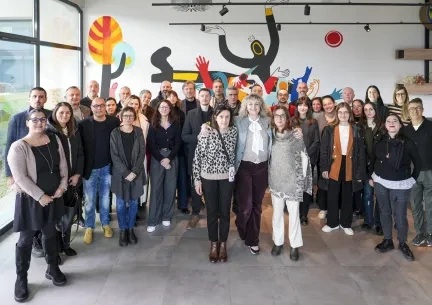Theme 1 - Project & Partnership Management: In terms of Project and Partnership Management, the shock brought about by the COVID-19 pandemic created significant challenges in three main areas considered here: 1) the forms of communication/interaction among partners and colleagues...
Theme 1 - Project & Partnership Management
In terms of Project and Partnership Management, the shock brought about by the COVID-19 pandemic created significant challenges in three main areas considered here: 1) the forms of communication/interaction among partners and colleagues; 2) the organisation of collaborative work and progress monitoring; 3) the emergence of unforeseeable barriers to the achievement of initial objectives.
Our study has shown how, under these circumstances, a project’s resilience to a shock/crisis is highly dependent on three essential factors:
Facilitating positive relations and ensuring a satisfactory level of bonding among colleagues and co-workers is crucial. The same is true regarding fostering interpersonal and informal connections within the working group, especially when relationships are mediated by a screen and strictly limited to the work meeting timeframes (and sometimes even occurring among people who have never physically met before). Projects that carry out effective team-building activities and establish enabling and welcoming environments are also those where team members are the most committed to the achievement of common goals, and therefore more prone to go the extra mile to ensure project success and resilience.
By definition, shocks disrupt the status-quo and thereby create new needs and priorities. For innovative projects led and managed by urban authorities, a severe shock like the pandemic often caused a shift in the values and priorities of the local administrations, which were suddenly called upon to respond to a whole new set of challenges and priorities. In this context, the most resilient projects have been those capable of re-assessing and re-evaluating their original plans and goals. Here, indeed, the key was flexibility in adapting to the new situation and being agile and creative in thinking outside the box, so that the project objectives would better align with new priorities at city level and their schedules would better match with local agendas.
Shocks may engender high levels of uncertainty with circumstances changing at a fast pace and often in unpredictable ways on several levels simultaneously. In this context, a key lesson from the direct experience of project managers is that of designing work plans that allow generous buffer time between tasks and permit the development of activities. Doing so is likely to prevent cascading effects from blockages or delays in the implementation chain. Projects that adopted such an approach also showed a higher resilience and capacity to overcome unforeseen challenges and obstacles.
Theme 2 - Citizens & Stakeholder Participation
In addition to adapting participatory approaches, codesign, and engagement processes either by making them COVID-compatible (smaller groups, outdoor, etc.), or by shifting to digital (wider outreach, less in-depth and long term, etc.), only a few projects reported structural revisions in terms of participation. For instance, CoGhent “added an online web-platform to give citizens online access to the cultural heritage to fit in with the post-pandemic ‘new normal’.
With just a few exceptions, the upheaval of the COVID-19 pandemic does not seem to have affected the DNA of the projects and their innovative character even though most of them rely on participation to create neighbourhood communities, build engagement platforms, reach out to disadvantaged populations, open public data, foster digital services, build capacities through digital literacy, etc.
When asked about the opportunity of changing the nature of their innovative approaches, some projects argued that their core innovation was already aligned with the new normal emerging from the pandemic i.e.: “the pandemic has strengthened the need for a smart, data-driven proactive administration and a tool like the one used in the Gavius project, making it more meaningful than ever.”
Other projects discussed the structure of the project and how the UIA allows them to adapt project content, as long as the focus is kept. They mentioned the possibility of rethinking core aspects of the innovation project despite already being in a post-pandemic catch-up phase with project implementation, and continuing to enjoy enough ‘agility’ and space for innovation. In other words, a new normal of flexibility is seen as desirable. Indeed, resilience is a question of flexibility during the project lifecycle: do projects keep their agility in order to continue to innovate? Are they free enough to deviate from their initial implementation route map?
Asking the question of the resilience of urban innovation projects and of their capacity to reorganise when confronted with a significant emerging problem or a structural crisis, also means questioning the way these projects approach the concept of innovation per se.
The main problem and crisis that any innovation project must face outside of any pandemic or catastrophic event is the current ‘normal’: by definition innovation clashes with a former reality it is aiming to change. Initial ideas turn out not to be as good as initially anticipated; target populations resist the innovation and new practices; the innovation is not as straightforward to implement as initially expected, etc. For all these reasons, innovation should be progressive, based on iterative trial and error, with progressive adjustments that maintain flexibility. Projects need the ability to reshuffle (tasks, priorities) to reinvent continuously until the end of the innovation process.
An emerging problem or crisis, even a major crisis like the COVID-19 pandemic, arguably includes all the challenges that an innovation project must anyway deal with. The current reality that the innovation seeks to change is also in a state of continuous change. Of course, the change is radical in case of the COVID-19 pandemic. If their approach is flexible and sufficiently adaptive, innovation projects should therefore be among the most resilient processes when a major crisis does emerge: they should be ‘resilient by default’.
In other words, if innovation projects find themselves in grave difficulty in the pandemic, if they are paralysed and incapable of reinventing themselves, if the only way forward is to postpone their project, then solutions may be found in revisiting their very approach to innovation, keeping implementation fluid, adopting smaller loops of experimentation-adaptation, daring to question the initial hypothesis right up to end of the process.
Now returning to the initial ultimate question of this study “(1) to understand the major challenges and barriers they faced while implementing their projects in order to (2) better develop their resilience capacities”, these preliminary investigations suggest an interesting conclusion ‒ and recommendation ‒ in order to be more resilient, innovation projects should be more fluid and agile in their innovation processes.
Theme 3 - Public Procurement & Finance
The COVID-19 shock placed public procurement processes under significant strain. This was due to the loss of key city personnel responsible for approving different stages/expenditure and to radical market instability, making accurate pricing impossible. These challenges stretched delivery times and significantly increased risks for suppliers. Medium to long term capital items were particularly badly affected (notably construction).
Projects found workarounds, principally by prioritising what they needed to procure and being more flexible in the terms and conditions they provided to suppliers. Successful projects noted that good communication was key throughout the process.
The collapse in the global supply of key materials meant some project tasks were unavailable or significantly delayed. Projects had to be flexible both in finding alternative solutions and in adapting timelines.
From a financial perspective, prices rose sharply. Since project budgets were fixed, project managers had to reduce the scope/specification of what they procured. Typically, this reduced the ‘ambition’ of a project. Project managers had a stark choice as they had to either change the project or halt its delivery. When making changes, they also had to manage the financial aspects of projects more actively by checking with suppliers and partners that their cash-flow was sufficient to allow them to remain engaged. These checks had to be undertaken frequently as the commercial operating environment was ‘fluid’. This meant more frequent financial management meetings and changing standard payment terms (faster payment from the invoice submission date, and accepting more frequent, but lower value, invoices).
In two instances, projects maintained (most of) their original scope by seeking additional funding from their host cities, which amounted to €1mn in total.
Another challenge for projects was working with fixed budgets that had been set several years before the COVID-19 shock. A contingency budget at project, local authority, and/or funders level could be the solution to cover unforeseen circumstances such as those encountered under COVID-19. For example, future EU funding programmes could include such a budget.
This research focused on how cities responded to the COVID-19 shock and identified areas of good practice and innovation exhibited by project partners.
Research published by leading policy organisations (public and private) emphasises the importance of cities’ flexibility, creativity, and agility when responding to shocks. This research also identifies the value of strong social networks coupled with good governance and government in shock situations.
A specific challenge introduced by COVID-19 was that it fundamentally undermined the effective operation of social networks at the city-region level. Citizens were instructed not to come together, collaborate, or mix. Many of the UIA projects included strong citizen engagement components - indeed for several, citizen engagement was the focus. Thus, COVID-19 had a particularly disruptive impact on UIA project delivery. When coupled with rapid supply-side price inflation, the disruption was significant.
The published resilience research summarised earlier in this study cited both the OECD (Economy, Society, Governance, Environment) policy model and the PWC (Sense-Defend-Respond-Recover coupled with re-organising people and physical assets) model. The findings of this study indicate clear alignment between these publications and the attributes of successful UIA projects. For example, UIA projects:
- were flexible - they changed their design, scope, and implementation structure in fundamental ways to maintain momentum.
- were agile - they responded rapidly to the changing conditions.
- did not ‘give up’ - there was a clear level of commitment (governance leadership) to ensure the original aims were achieved as far as possible.
- adopted novel and innovative delivery approaches - not just in terms of using technology (which was very significant), but also in terms of the commercial, procurement, and project management aspects.
- were pragmatic - recognising that the original aspirations for the project could not be achieved due to COVID-related impacts within the city and the broader economy.
- (when the societal restrictions were relaxed) quickly applied conventional approaches, coupled with new innovations adopted during COVID-19 - thus there is a legacy uplift in resilience that the COVID-19 shock has delivered.
Overall, it can be seen from this study that cities participating on successful UIA projects clearly exhibited recognised resilience characteristics and that, in certain cases, their resilience was enhanced through adopting innovative solutions to the crisis that will have a legacy benefit.
About this resource
The Urban Innovative Actions (UIA) is a European Union initiative that provided funding to urban areas across Europe to test new and unproven solutions to urban challenges. The initiative had a total ERDF budget of €372 million for 2014-2020.
Similar content




